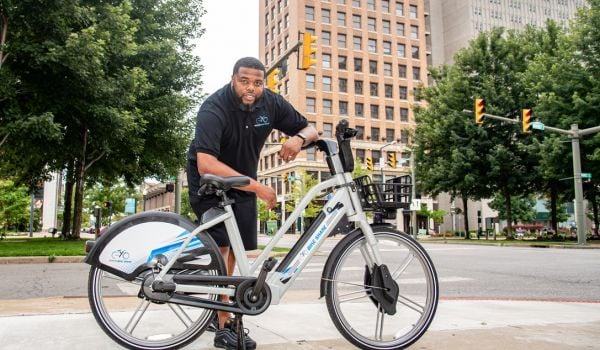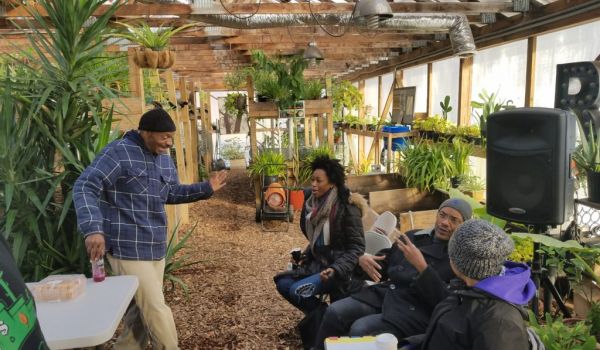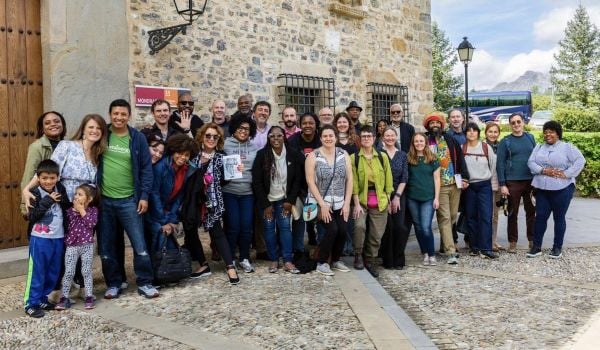A fresh wooden walkway led up to the front door of The Fringe, a cozy coffee shop tucked off High Street in downtown Hamilton, Ohio. Inside, every wall was covered with bright murals and the two story space was populated with plants and funky furniture.
A few months ago the parking lot was populated by cars and the “OPEN” sign shone in the front window. Workers could be heard chatting in the kitchen.
“What can I say, I am a felon,” one employee deadpanned, met by laughter from the others.
The Fringe is a re-entry program for those who were formerly incarcerated, reintegrating or generally living on the fringes of society. Down to its wifi network name, The Fringe is entirely about second chances.
But now the parking lot is vacant and shutters are pulled on every window. No employees are laughing in the kitchen and the drive through is empty.
Organizations like The Fringe work to fill the gaps of the prison system that leave so many individuals struggling to re-enter society. Individual and community supported organizations and networks like it provide access to the employment, housing and social support that are neglected by current re-entry strategies.
But without any form of institutional, state or federal funding these community networks often struggle to turn enough of a profit to support each individual and remain a functioning business.
On April 22, The Fringe closed its doors for the second time since its 2020 founding, sharing the announcement via their Facebook page.
Community involvement and support is a key aspect of successful re-entry, but working to generate adequate non-profit funding as well as customer traffic has limited the ability of the community to support some of its most vulnerable members.
The United States has the highest prison population of any country and one of the highest rates of recidivism as well. The National Institute of Justice reports that nearly 44% of released individuals reoffend within a year of their release date. Ohio has a three year recidivism rate of 31%.
Efforts to reduce crime tend to focus on putting more people behind bars, getting criminals off the streets and setting an example with long sentences and harsh punishments. The same attention is not paid to the process of rehabilitation.
“You want to slowly integrate back into society,” Samantha, an employee of The Fringe for one year, says. “But life does not wait for you to catch up. It’s like jumping on a moving train.”
Michael Wetmore, a visiting assistant professor at Albany Law School and former district attorney and appellate prosecutor, refers to the current approach to re-entry after incarceration as a “one-size-fits-all, assembly line” model.
Little support is provided to individuals leaving prison. Probation officers are meant to be a mechanism of preventing any further criminal activity, but individuals are on their own in securing housing, employment and transportation, re-establishing relationships and routines on the outside and coping with the traumas of prison and individual circumstances.
Each employee of The Fringe sits down with owners Sarah and Patrick Davis to discuss their specific circumstances and devise a personalized re-entry plan. Depending on the needs of each employee, The Fringe offers G.E.D tutoring, financial literacy education, parenting classes, mental health services, addiction and recovery meetings, music and art therapy and free tattoo removal for racist or gang related tattoos.
Jesse, a 29-year-old Hamilton native, is a brand new hire of The Fringe and waiting for his intake meeting.
He started selling drugs at 13 and later began using as a coping mechanism after losing several loved ones. Incarcerated nearly two dozen times as a juvenile, Jesse says that he was resistant to intervention efforts when he was young and had to reach the point of wanting to better his life for his own sake.
“A kid is going to think that they know everything, I know I did. I thought I had been through it all and knew everything and nobody could tell me nothing. They tried to help me as much as possible, but really it takes experience to understand.”
Being released back into the same community and same environment that one originally committed their crimes in is a major factor in the issue of rehabilitation. Individual family situations, peer pressure and lack of social, economic and educational support and opportunities easily sets the stage for a re-offense.
“I always got myself sober, but always fell back into selling drugs,” Jesse says. “The lifestyle of Hamilton is always there to pull you back in. You have to want different.”
Jesse says that he wants to begin really living his life and pursuing his goals. He hopes to own his own business: a hybrid barber and tattoo shop. He is fighting to break the cycle that dominated the first 29 years of his life, and to be defined by more than his past.
Stigma, stereotypes and generalizations about those who have been incarcerated can easily make individuals working towards rehabilitation feel solely defined by their mistakes and crimes.
“Your past is your past, it isn’t what makes you who you are as a person, it’s the actions that come after it,” Jesse says.
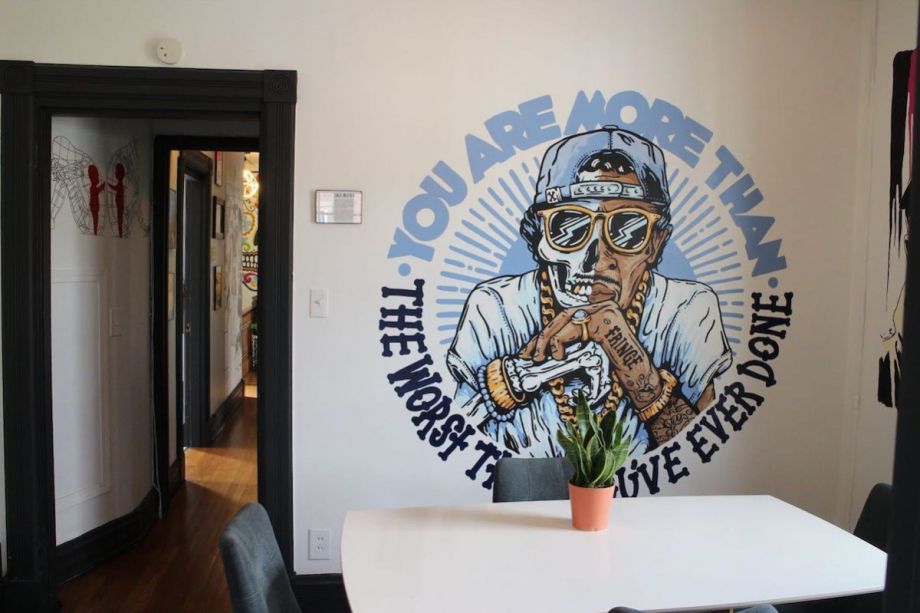
The two-story space was decorated with colorful murals echoing the core message of redemption and growth. (Photo by Emma Wilcox)
This sentiment is echoed throughout The Fringe, with murals, T-shirts and business cards all stating, “You are more than your past.”
Samantha, 29, grew up in the Hamilton area and remembers hearing about the upcoming opening of The Fringe before her own incarceration.
Arrested at the end of 2019, Samantha did not share the experiences of the eerily empty grocery stores and makeshift masks of the early COVID-19 pandemic days. Instead, she and the other inmates were kept on lockdown 23 hours a day and she was unable to have visitors for her entire two year sentence.
She served two years for burglary charges, but considers herself lucky not to have served longer.
Samantha was arrested in Dearborn County, Indiana, a rural area that sends more people to prison than nearly any other county in the country. The county is also known for long “tough on crime” sentences.
“It’s like a survivor’s guilt kind of sensation,” Samantha says. “Because I know there are people in there who are never coming out … I have all these people that I care about that I know are in there and sometimes I’ll look at the clock and be like ‘It’s almost chow time for them.’ It’s weird thinking of all these people that are left behind and forgotten.”
Samantha ultimately attributes her crime to issues of mental illness and had hoped the prison institution would offer support.
“I remember getting there and thinking maybe I’ll get the help I need and they say prison is supposed to rehabilitate you … but for me seeing psych was just somebody saying ‘are you feeling homicidal? Suicidal? Nope, okay, see you in ninety days.’ So I never got the help I needed.”
She was able to use her time to read self-help books and reflect on how she planned to rebuild her life once released, but the failure to provide effective programming and support systems strips prison of any rehabilitative aspects. Without addressing the root causes of criminal activity, prison becomes a “school” of crime and criminal socialization.
Legal expert Wetmore emphasizes the need for an individualized approach to re-entry. One that addresses each individual’s needs, circumstances and root cause of criminal activity.
“Parolees and inmates, when they are released out into the community, there’s a one-size-fits all approach and it’s proven to not be very effective,” Wetmore says. “The better way to approach re-entry into the community is an individualized treatment for that individual. Find out that individual’s needs. Find out the individual’s motivation, the driving force toward offending … And then tailor the re-entry plan to the individual.”
Substance abuse, mental illness, lack of education, financial stress and numerous other factors drive people to commit crime. Wetmore emphasizes that failing to address and resolve these core causes of criminal activity sets the stage for a re-offense and a return to prison.
But Wetmore believes that addressing recidivism begins long before an individual reaches re-entry by diverting individuals from incarceration in the first place.
Alternatives to incarceration include drug court and substance abuse treatment programs, mental health treatment, probation, community service and community based intervention and treatment efforts.
Many of the employees of The Fringe share similar aspects of their stories. They describe experiences of addiction and abuse, tragedy, turning to crime as a means of surviving, untreated mental illness and lack of social support.
Lauren, 36, shared her handwritten testimony, describing herself as a little girl who longed for her father’s approval but ended up with addiction and sugar daddies instead. When she resorted to crime to fuel her drug addiction she cycled in and out of jail and lost custody of her two kids.
Lauren is working to heal her inner child from the abuse and trauma she dealt with as a child and young adult just as much as she is working to prove herself to be a sober and capable employee and parent.
Lauren is now sober, taking part in a faith-based rehabilitation program and working to regain custody of her kids.
Elizabeth, 34, was able to use her time in prison as a means of getting sober and focusing on self-reflection. She now helps run Narcotics Anonymous meetings and is a volunteer at the Salvation Army.
Despite being sober and already working to regain custody of her children, Elizabeth has faced a great deal of stigma in her journey to re-entry.
“I dealt with being in active addiction before I went to prison,” she says. “You have a lot of people that you, not necessarily have to prove wrong, but just show that you’ve changed and you’re working on bettering yourself.”
The Fringe has offered both Lauren and Elizabeth much needed stability that has helped them establish foundations of a successful adult life — utility bills and a bank account under Elizabeth’s name for the first time, a supportive community of unconditional acceptance, a job and volunteer opportunities, the goal of owning a home.
Much of recidivism and re-entry comes down to the support and services available to an individual and the capacity of the prison system and community organization to provide this support.
Patrick and Sarah Davis remain committed to their mission and the importance of their work and plan to re-open The Fringe as soon as possible.
Emma Wilcox is a recent graduate of Miami University in Ohio, with degrees in journalism and women's and gender studies.

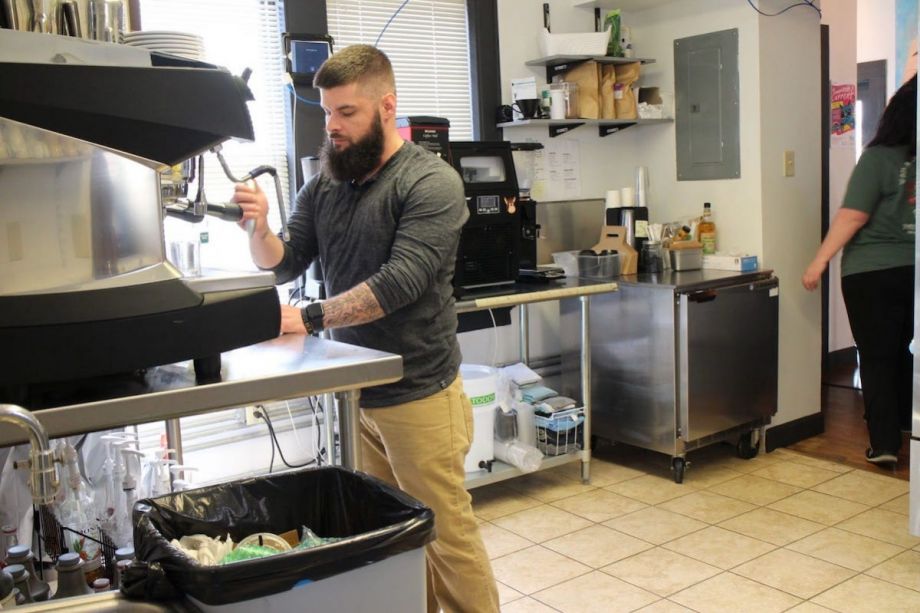
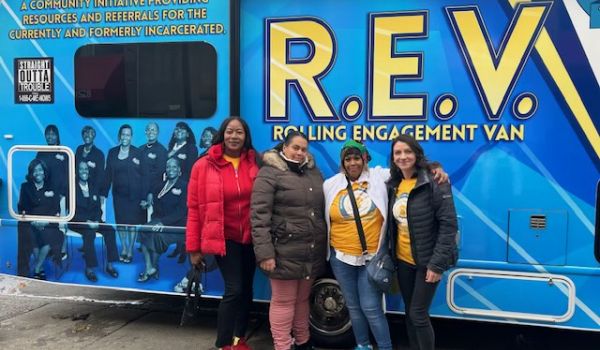


__Sean_Corrigan_from_Cleveland_Sews_(center)__and_Paula_Coggins_from_Oh_Sew_Powerful_(right)_sew_leftover_banners_from_the_NFL_Draft_into_handbags_-_photo_by_Sophie_Kannberg_600_350_80_s_c1.jpeg)
